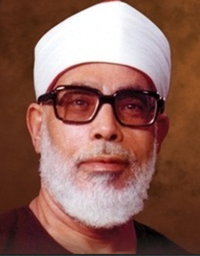
Anyone who knows anything about Quranic recitation knows that Shaykh Mahmud Khalil al-Husary is an absolute LEGEND. He was considered the Imam or Shaykh amongst the Qurra of his time (which featured such heavyweights as Shaykh Abdulbasit Abdussamad, Shaykh Muhammad Siddiq al-Minshawi, Shaykh Mustafa Ismail, etc). Not only was he a professional reciter, but he was also an outstanding scholar of the Quran. During his lifetime he recorded the entire Quran numerous times: in the riwayah of Hafs ‘an ‘Aasim (in the murattal, mujawwad, and mu’allim styles), as well as recitations in the riwayat of Qaloon and Warsh ‘an Nafi’, as well as ad-Duri ‘an abu-‘Amr. Even to this day, countless children from around the world continue to learn from his recitations. We ask Allah to shower him with His mercy, to forgive any of his shortcomings, to admit him into the highest levels of Jannah, and to forever preserve his legacy.
Since you are looking to beautify your recitation and learn the vocal arts connected to recitation, I want to draw your attention to three lessons we can take from Shaykh al-Husary’s recitations:
LESSON 1: RECITE WITH PROPER TAJWEED
Shaykh al-Husary’s precision in tajweed is simply amazing, to the point that his recitation is considered to be authoritative. Every madd, every ghunnah, and every harakah is given its complete due. Nowadays we’ll find that some people might try to beautify their recitation by imitating their favourite Qari or by learning some of the maqamat patterns, but if they have no background in tajweed they could very well end up ruining their recitation. Remember: tajweed is the foundation and basis of a great recitation.
LESSON 2: RECITE IN TUNE
From the perspective of tune/melody, Shaykh al-Husary recites predominantly in maqam nahawand. But if you’ve ever heard him recite, you’ll know that he does so without much ornamentation or huge variances in pitch – basically, he keeps it simple. He recites within a limited range and within that range, he stays “in tune” (aka “on pitch”), and there is no nashaz (discord) in his recitation. Sometimes when students are interested in beautifying their recitation, they think this means they have to be able to play with their voice a lot or be able to recite at high pitch levels, but when they try to do so they end up going “off tune” and introducing breaks in their voice. There’s no harm in keeping it simple until you are able and ready to operate your voice smoothly. Remember: staying “in tune” and not having nashaz in your voice is the biggest thing that will determine whether overall your recitation sounds pleasant or unpleasant.
LESSON 3: RECITE FROM YOUR HEART
The final lesson I want to share with you is regarding spirituality. When you listen to Shaykh al-Husary, his recitation touches your heart and you immediately get the sense that he recites with a fully engaged heart. Shaykh al-Husary brings to my mind a hadith where we learn that the reciter with the most beautiful voice is the one who conveys fear of Allah. As a student of recitation, you can never sell yourself short by trading your khushoo’ for anything else. Sometimes when students start learning tajweed or maqamat, their mind might be focused on what they’re learning – this is natural, but it is not ideal. Try to take separate time for practice and don’t turn your salah into a tajweed/vocal practice session. Remember: the best Qurra inspire others with the book of Allah. If you wish to recite like them, you must start with engendering taqwa within yourself.
I ask Allah to bless you in your recitation of His book, and I ask Him to bless our Ummah with more of the likes of Shaykh Mahmud Khalil al-Husary (rahimahullah).


